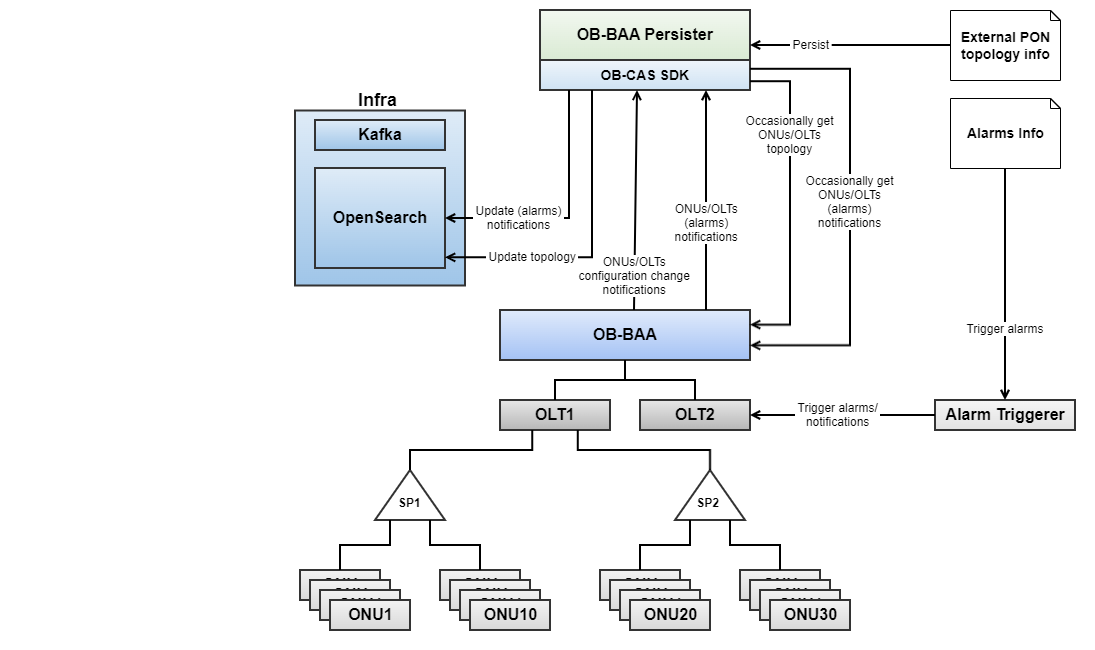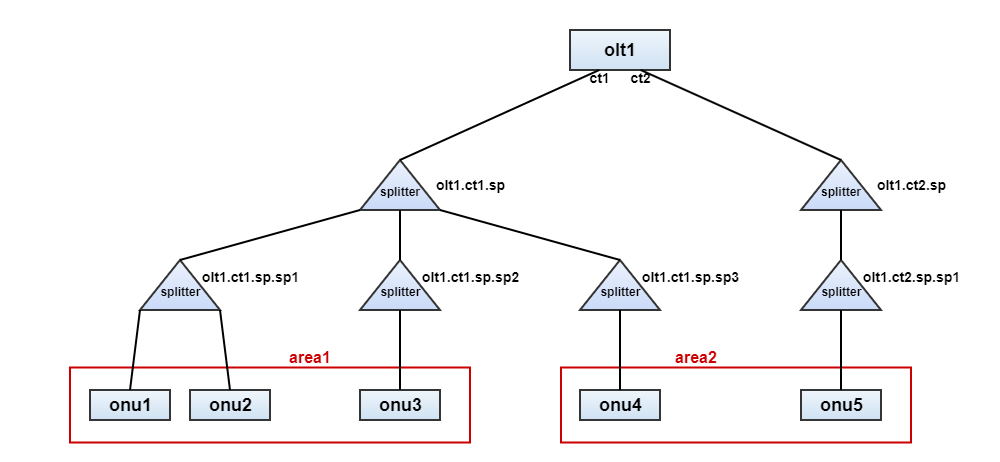OB-CAS Persister
Functional Description
This application is responsible to persist PON information including PON topology (OLTs, ONUs, channel terminations, etc.), alarms, and other notifications in the OpenSearch database, and keep this up to date.
The figure below shows how the Persister App is integrated within the OB-CAS sandbox comprising the OB-BAA core.

Controller-provided PON Topology
The persister application subscribes to the configuration-change notifications in the OB-BAA, and it updates the PON topology indexes in the OpenSearch whenever it receives a configuration-change notification. Additionally, the application can occasionally send NETCONF GET requests toward OB-BAA to retrieve the existing devices and updates the topology indexes in the OpenSearch. This would be beneficial when the application misses some notifications, for example because of failures. Some examples of ONU and OLT documents are shown below:
An ONU document in the onus index
{
"deviceRefId": "onu1",
"serialNumber": "ABCD12345678",
"aniRefId": "an1",
"olt": "olt1",
"channelTermination": "olt1.ct1",
"splitter1": "olt1.ct1.sp.sp1",
"splitter2": "olt1.ct1.sp",
"vendor": "alcl",
"vomci": "vomci1",
"powerDistributionArea": "area1"
}
An OLT document in the olts index
{
"deviceRefId": "olt1",
"cabinet": "server_room_1"
"vendor": "bbf"
}
Some part of this information can be retrieved from the notifications coming from OB-BAA. For example, the information about the channelTermination through which an ONU is connect to an OLT can be retrieved from the “onu-presence-state-change” notification which is raised when ONU is ranged in the OLT.
External PON Topology
Some other part of PON information cannot be retrieved from OB-BAA, but needs to be inserted explicitly by the operators. For example, the splitter through which an ONU is connected to the PON should be explicitly inserted into the document by the operator. Another example of such information is the location of devices.
There should be a REST API in the PON persistor application, namely “/external_pon_topology”, that accepts external PON topology information and inserts this information in the appropriate PON topology indexes in OpenSearch. An example of external PON topology and its graphical representation are shown below:
External PON topology example
{
"onu": [
{
"deviceRefId": "onu1",
"splitter1": "olt1.ct1.sp.sp1",
"splitter2": "olt1.ct1.sp",
"location": "building1",
"powerDistributionArea": "area1"
},
{
"deviceRefId": "onu2",
"splitter1": "olt1.ct1.sp.sp1",
"splitter2": "olt1.ct1.sp",
"location": "building2",
"powerDistributionArea": "area1"
},
{
"deviceRefId": "onu3",
"splitter1": "olt1.ct1.sp.sp2",
"splitter2": "olt1.ct1.sp",
"location": "building3",
"powerDistributionArea": "area1"
},
{
"deviceRefId": "onu4",
"splitter1": "olt1.ct1.sp.sp3",
"splitter2": "olt1.ct1.sp",
"location": "building3",
"powerDistributionArea": "area2"
},
{
"deviceRefId": "onu5",
"splitter1": "olt1.ct2.sp.sp1",
"splitter2": "olt1.ct1.sp",
"location": "building4",
"powerDistributionArea": "area2"
} ],
"olt": [
{
"deviceRefId": "olt1",
"cabinet": "room1",
"powerDistributionArea": "area3"
},
{
"deviceRefId": "olt2",
"cabinet": "room1",
"powerDistributionArea": "area3"
}
]
}

Alarms
The persister application subscribes to the alarms notifications in the OB-BAA, and it updates the alarm indexes in the OpenSearch whenever it receives an alarm notification. Additionally, the application can occasionally send NETCONF GET requests toward OB-BAA to retrieve the existing alarms and updates the alarm indexes in the OpenSearch. This would be beneficial when the application misses some notifications, for example because of failures.
When an alarm is raised the persister application stores it in the active_alarms index. Later, when the alarm is cleared the alarm will be moved into the history_alarms index. Some examples of alarms documents are shown below:
An alarm document in active_alarms index
{
"alarmResource": "baa-network-manager:network-manager/baa-network-manager:managed-devices/baa-network-manager:device[baa-network-manager:name='ont1']/baa-network-manager:root/if:interfaces/if:interface[if:name='enet_uni_ont1_1_1']",
"alarmTypeId": "bbf-baa-ethalt:loss-of-signal",
"alarmTypeQualifier": null,
"perceivedSeverity": "major",
"alarmText": "Loss of signal detected",
"alarmStatus": "Raised",
"raisedTime": "2024-05-27T06:17:08.000Z",
"deviceRefId": "ont1"
}
An alarm document in history_alarms index
{
"alarmResource": "baa-network-manager:network-manager/baa-network-manager:managed-devices/baa-network-manager:device[baa-network-manager:name='ont1']/baa-network-manager:root/if:interfaces/if:interface[if:name='enet_uni_ont1_1_1']",
"alarmTypeId": "bbf-baa-ethalt:loss-of-signal",
"alarmTypeQualifier": null,
"perceivedSeverity": "cleared",
"alarmText": "Loss of signal cleared",
"alarmStatus": "Cleared",
"clearedTime": "2024-05-27T06:21:56.000Z",
"deviceRefId": "ont1",
"raisedTime": "2024-05-27T06:17:08.000Z"
}
Other notifications
Persistor application also subscribes to the other notifications coming from OB-BAA. The application needs to categorize these notifications into two category: 1) active (undesired state) notifications, the ones that need attention, for example an onu-presence-state-change notification that reports onu-not-present, and 2) history (desired state) notifications, the ones that do not need attention, for example an onu-presence-state-change notification that reports onu-present-and-on-intended-channel-termination. Accordingly, there are two indexes for storing the notifications: active_notifications and history_notifications.
A defect-state-change (undesired state) notification received by the persister application
<notification xmlns="urn:ietf:params:xml:ns:netconf:notification:1.0">
<if:interfaces-state xmlns:if="urn:ietf:params:xml:ns:yang:ietf-interfaces">
<if:interface>
<if:name>van1</if:name>
<bbf-xponvani:v-ani xmlns:bbf-xponvani="urn:bbf:yang:bbf-xponvani">
<bbf-xponvani:defect-state-change>
<bbf-xponvani:defect>
<bbf-xponvani:type>bbf-xpon-def:dgi</bbf-xponvani:type>
<bbf-xponvani:state>raised</bbf-xponvani:state>
<bbf-xponvani:last-change>2024-02-01T02:02:00Z</bbf-xponvani:last-change>
</bbf-xponvani:defect>
</bbf-xponvani:defect-state-change>
</bbf-xponvani:v-ani>
</if:interface>
</if:interfaces-state>
</notification>
A (defect-state change) notification document in the active_notifications index
{
"vAniRefId": "van1",
"deviceRefId": "ont1",
"alarmTypeId": "obcas-notification-alarm:v-ani-defect",
"alarmResource": "baa-network-manager:network-manager/baa-network-manager:managed-devices/baa-network-manager:device[baa-network-manager:name='olt1']/baa-network-manager:root/if:interfaces-state/if:interface[if:name='van1']",
"time": "2024-01-01T00:00:00Z"
}
##Implemented format:
{
"vAniRefId": "ontAni_ont1",
"alarmTypeId": "obcas-notification-alarm:v-ani-defect",
"alarmStatus": "raised",
"deviceRefId": "ont1",
"alarmResource": "baa-network-manager:network-manager/baa-network-manager:managed-devices/baa-network-manager:device[baa-network-manager:name='OLT1']/baa-network-manager:root/if:interfaces-state/if:interface[if:name='ontAni_ont1']",
"raisedTime": "2024-02-01T02:02:00Z"
}
A defect-state-change (desired state) notification received by the persister application
<notification xmlns="urn:ietf:params:xml:ns:netconf:notification:1.0">
<if:interfaces-state xmlns:if="urn:ietf:params:xml:ns:yang:ietf-interfaces">
<if:interface>
<if:name>van1</if:name>
<bbf-xponvani:v-ani xmlns:bbf-xponvani="urn:bbf:yang:bbf-xponvani">
<bbf-xponvani:defect-state-change>
<bbf-xponvani:defect>
<bbf-xponvani:type>bbf-xpon-def:dgi</bbf-xponvani:type>
<bbf-xponvani:state>cleared</bbf-xponvani:state>
<bbf-xponvani:last-change>2024-02-01T03:02:00Z</bbf-xponvani:last-change>
</bbf-xponvani:defect>
</bbf-xponvani:defect-state-change>
</bbf-xponvani:v-ani>
</if:interface>
</if:interfaces-state>
</notification>
A (defect-state change) notification document in the history_notifications index
{
"vAniRefId": "van1",
"deviceRefId": "ont1",
"alarmTypeId": "obcas-notification-alarm:v-ani-defect",
"alarmResource": "baa-network-manager:network-manager/baa-network-manager:managed-devices/baa-network-manager:device[baa-network-manager:name='olt']/baa-network-manager:root/if:interfaces-state/if:interface[if:name='van1']",
"time": "2024-01-01T00:00:00Z",
"clearedTime": "2024-01-01T00:00:33Z"
}
## Implemented format
{
"vAniRefId": "ontAni_ont1",
"alarmTypeId": "obcas-notification-alarm:v-ani-defect",
"alarmStatus": "cleared",
"clearedTime": "2024-02-01T03:02:00Z",
"deviceRefId": "ont1",
"alarmResource": "baa-network-manager:network-manager/baa-network-manager:managed-devices/baa-network-manager:device[baa-network-manager:name='OLT1']/baa-network-manager:root/if:interfaces-state/if:interface[if:name='ontAni_ont1']",
"raisedTime": "2024-02-01T02:02:00Z"
}
Setting up OB-CAS Persister Application
Prior to building docker image for the OB-CAS Persister Application, make sure OB-CAS App environment is setup based on the instructions detailed here
Build OB-CAS SDK Docker Image
cd obcas/src/obcas_sdk
make docker-build
Build OB-CAS Persister App Docker Image
cd obcas/src/obcas_apps/persister_app/
make docker-build
Start OB-CAS Persister App using Docker-Compose
-
Pre-Requisites
-
OB-BAA must be up and running
-
Opensearch and opensearch dashboard applications must be up and running ~/obcas/src/obcas_sdk/opensearch_handler/data/docker-compose.yml
-
Update the Env variable OPENSEARCH_HOST, BAA_SERVER_IP in ~/obcas/src/obcas_apps/persister_app/docker-compose.yaml
-
Note: Update the correct IP address of OB-BAA, OPENSEARCH containers
-
-
Starting OB-CAS Persister App
- Navigate to the directory cd obcas/src/obcas_apps/persister_app
- Start docker container by running command docker-compose up -d
- Note: As soon as the container is started, it will subscribe to ALARM stream. Whenever an alarm is received Persister app parses the alarm and push it to opensearch DB.
